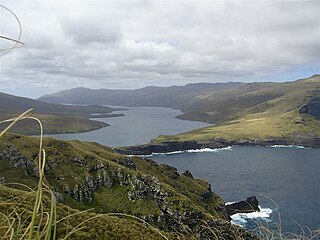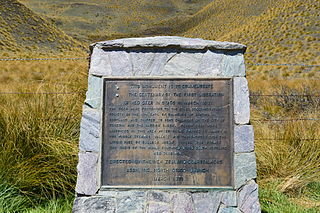
Arapaoa Island, formerly known as Arapawa Island, is an island located in the Marlborough Sounds, at the north east tip of the South Island of New Zealand. The island has a land area of 75 km2. Queen Charlotte Sound / Tōtaranui defines its western side, while to the south lies Tory Channel / Kura Te Au, which is on the sea route from Wellington in the North Island to Picton. Cook Strait's narrowest point is between Arapaoa Island's Perano Head and Cape Terawhiti in the North Island.

Auckland Island is the main island of the eponymous uninhabited archipelago in the Pacific Ocean. It is part of the New Zealand subantarctic area. It is inscribed in the UNESCO World Heritage list together with the other New Zealand Subantarctic Islands in the region.

The red squirrel is a species of tree squirrel in the genus Sciurus common throughout Europe and Asia. The red squirrel is an arboreal, primarily herbivorous rodent.

Kaimanawa horses are a population of feral horses in New Zealand that are descended from domestic horses released in the 19th and 20th centuries. They are known for their hardiness and quiet temperament. The New Zealand government strictly controls the population to protect the habitat in which they live, which includes several endangered species of plants. The varying heritage gives the breed a wide range of heights, body patterns and colours. They are usually well-muscled, sure-footed and tough.

In agriculture, grazing is a method of animal husbandry whereby domestic livestock are allowed outdoors to roam around and consume wild vegetations in order to convert the otherwise indigestible cellulose within grass and other forages into meat, milk, wool and other animal products, often on land unsuitable for arable farming.

Countryfile is a British television programme which airs weekly on BBC One and reports on rural, agricultural, and environmental issues in the United Kingdom.

The ecological restoration of islands, or island restoration, is the application of the principles of ecological restoration to islands and island groups. Islands, due to their isolation, are home to many of the world's endemic species, as well as important breeding grounds for seabirds and some marine mammals. Their ecosystems are also very vulnerable to human disturbance and particularly to introduced species, due to their small size. Island groups such as New Zealand and Hawaii have undergone substantial extinctions and losses of habitat. Since the 1950s several organisations and government agencies around the world have worked to restore islands to their original states; New Zealand has used them to hold natural populations of species that would otherwise be unable to survive in the wild. The principal components of island restoration are the removal of introduced species and the reintroduction of native species.

The Bagot goat is a breed of goat which for several hundred years has lived semi-wild at Blithfield Hall, Staffordshire, England.
Enderby Island Cattle are a breed of cattle that existed in a wild state in isolation on Enderby Island, New Zealand for over 80 years. Only about seven specimens remain today,, after a rescue expedition by the Rare Breeds Conservation Society of New Zealand (RBCSNZ), and a culling program to protect the native flora and fauna of Enderby Island. There have since been intensive efforts at breeding the cattle, involving both in vitro fertilisation and cloning, and there is an ongoing program to perpetuate the breed in captivity.

Sheep are domesticated, ruminant mammals typically kept as livestock. Although the term sheep can apply to other species in the genus Ovis, in everyday usage it almost always refers to domestic sheep. Like all ruminants, sheep are members of the order Artiodactyla, the even-toed ungulates. Numbering a little over one billion, domestic sheep are also the most numerous species of sheep. An adult female is referred to as a ewe, an intact male as a ram, occasionally a tup, a castrated male as a wether, and a young sheep as a lamb.

The feral goat is the domestic goat when it has become established in the wild. Feral goats occur in many parts of the world.

The goat is a domesticated species of goat-antelope typically kept as livestock. It was domesticated from the wild goat of Southwest Asia and Eastern Europe. The goat is a member of the animal family Bovidae and the tribe Caprini, meaning it is closely related to the sheep. There are over 300 distinct breeds of goat. It is one of the oldest domesticated species of animal, according to archaeological evidence that its earliest domestication occurred in Iran at 10,000 calibrated calendar years ago.

Willowbank Wildlife Reserve is a wildlife park and nature reserve in Christchurch, New Zealand.

The Arapawa Sheep is a breed of feral sheep found primarily on Arapaoa Island in the Marlborough Sounds, New Zealand, where they have probably been isolated since they were introduced in 1867. Although there are many theories of how the sheep arrived, it is generally accepted that they are descendants of Merino strains from Australia. The New Zealand Rare Breeds Conservation Society classifies this breed as "rare". This breed is raised primarily for wool.

Hunting is a popular recreational pursuit and a tourist activity in New Zealand with numerous books and magazines published on the topic. Unlike most other developed countries with a hunting tradition, there are no bag-limits or seasons for hunting large game in New Zealand. Hunting in national parks is a permitted activity. The wide variety of game animals and the limited restrictions means hunting is a popular pastime which has resulted in a high level of firearms ownership among civilians.

Adam John Lincoln Henson is an English farmer, author and television presenter.

The Arapawa pig is a feral breed of domestic pig found on Arapaoa Island in the Marlborough Sounds, New Zealand. Although there are suggestions that the animals are descendants of pigs introduced to the area by James Cook in 1773 and 1777, they apparently derive from Oxford Sandy and Black stock brought to the island by whalers of the Te Awaiti whaling station established in 1827 by John Guard. They are known to have inhabited the island since 1839. In 1998 four piglets were removed from the island and have since bred successfully.

Hamilton Island is an island of the Whitsunday Islands in Queensland, Australia. It is approximately 887 kilometres (551 mi) north of Brisbane and 512 kilometres (318 mi) south of Cairns.

The British primitive goat is a landrace of domestic goat native to Great Britain and Ireland, and is the original goat of the region. It is considered a rare breed, existing as several, isolated feral herds, as some captive populations in zoological parks and nature reserves, and breeding stock on some private farms operated by groups of rare-breed enthusiasts. As few as 1,200 individual British primitives may remain. The variety is also referred to as the British native goat, the old British goat, the old English goat or the British landrace goat, among more specific names It descends from the earliest goats brought to the region in the Neolithic era, around 3,000 BCE. It is classified in the Northern breed group of goats. A population in Northumbria is sometimes referred to as the Cheviot goat. The British primitive is among the foundation stock of some modern standardised breeds, including the Anglo-Nubian goat. The breed is comparatively small, with commensurately low milk production. It is hardy and wiry haired, adapted to rough terrain and weather, and able to subsist and breed on its own without human intervention.


















